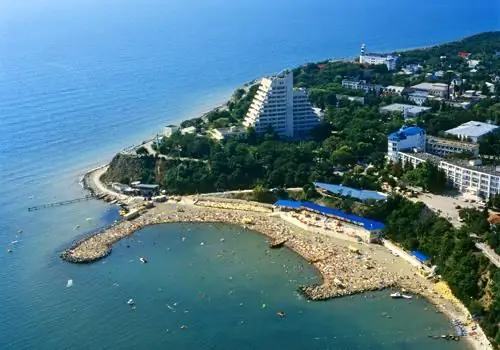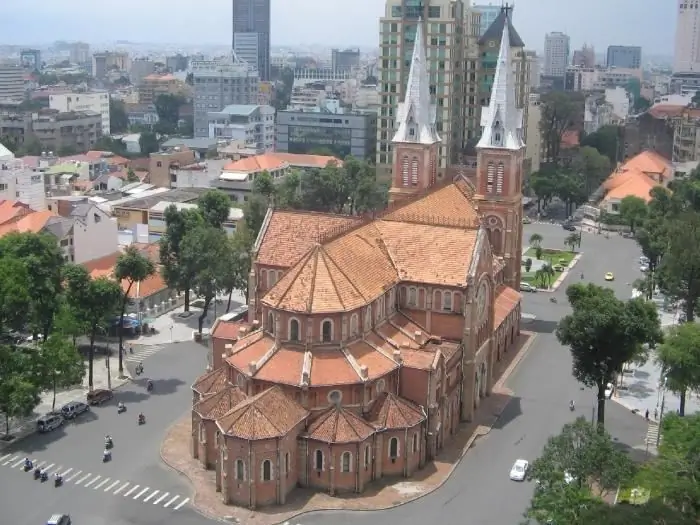- Author Harold Hamphrey [email protected].
- Public 2023-12-17 10:06.
- Last modified 2025-06-01 07:20.
The Labrador Sea, located in Canada, is the northernmost natural body of water in the Atlantic. Scientists have found that its water area was formed as a result of tectonic activity, which led to the separation of Greenland from North America. The separation itself took place over forty million years ago.

Sea Labrador: description
The Labrador Sea is adjacent to the Baffin Sea, and also has free access to the North Atlantic Ocean. In addition, through the Labrador Sea you can get to the Hudson Bay by sailing through the strait of the same name. Due to its favorable geological location, a number of bays flow into the water area, including:
- Hamilton.
- Saglek.
- Humberend.
- Gor.
- I'll steal it.
Location
The Labrador Sea is an oceanic inter-island body of water belonging to the Atlantic Ocean basin. It washes the shores of the following islands:
- Baffin Island.
- Greenland.
- Newfoundland.
Also the sea borders onthe Labrador Peninsula from which it takes its name. In order to find on the map where the Labrador Sea is located, it is enough to know the following coordinates:
- North latitude - 66°00’.
- West longitude - 55°00’.

Depth and topography of the bottom
Most of the bottom of the Labrador Sea is composed of igneous rock that has been released as a result of tectonic activity. The relief has a pronounced dissected shape. The continental slope, shelf and bed are quite clearly visible in it.
The shelf of the Labrador Sea is wide, with an approximate length of 250 km. It stretches along the coasts of Newfoundland and the Labrador Peninsula. As a rule, in coastal zones the relief is complex. There are often depressions, large reefs and shoals. Closer to the center of the sea, underwater canyons of various depths appear, and in the southeast side, the depth of the reservoir gradually increases.
The average depth of the Labrador Sea is 1900 meters, but in some places it can reach 4000 meters.
Climate
The geographical location of the reservoir determines its climate. The Labrador Sea is located in relative proximity to the Arctic, so throughout the year you can observe the movement of icebergs in its waters.
The inter-island sea is strewn with blocks of floating ice even in summer. As a rule, the water temperature is kept at around 0.5 °С and only in August the surface layer warms up to 6-7 °С.
The hydrological regime of the reservoir is ambiguous, since bothwarm and cold currents. The northern air masses influence the climate of the sea quite strongly. For example, cyclones moving along the Gulf Stream bring icy air from the continents, making the winter on the Labrador Sea harsh. The lowest temperatures are in January and February. During these months, the average temperature in the western part of the sea is -18 °C. In the eastern waters, the climate is less severe, here the average monthly air temperature varies between -3 - -9 ° С.

Winter and summer
In autumn and winter, relatively calm north-western and south-western winds, the speed of which varies within 11 m/s, usually prevail over the sea. However, storm winds are not uncommon in this region.
The minimum temperature lasts almost the whole year, and only with the onset of summer, which lasts only two months and falls on July-August, the air and the upper layer of water warm up to 6-12 ° C, and in the northwestern part of the sea - up to 8°С. In contrast to the autumn-winter season, storm winds are practically not observed in summer. The speed of air currents, which most often come from North America, varies between 5-6 m / s.
Summer at the Labrador Sea is relative. It is almost always cool and rainy here. The sun only occasionally peeks out from behind the clouds, dispelling thick fogs.
Currents
Winds that blow almost constantly in autumn and winter, as well as the unstable water column of the central part of the reservoir, create ideal conditions for intensivemixing of the upper marine layer. Ice-free waters are mixed to a depth of 35-40 m. In coastal areas, where the water column is less dense and partially covered with ice, the top layer is mixed at depths of up to 25 m.
Autumn-winter temperature drop, sometimes leading to partial freezing, excites convection. Over a large area of the central part of the reservoir, the temperature drops rapidly, which leads to an increase in the density of Atlantic saline flows, provoking convective mixing.
Often, convection reaches a depth of 400 meters. Further mixing occurs due to various dynamic processes, as well as by sliding of denser water masses along various underwater elevations. In shallow areas of the sea where ice formation is observed, as a rule, the so-called winter vertical circulation occurs, which allows water to be mixed to the very bottom of the reservoir.

The Labrador Sea (photo taken during a storm, see above) is quite large. Powerful winds regularly blow over the reservoir, provoking significant unrest. As a rule, the most serious disturbances are observed from September to April. At this time, the waves most often reach a height of 3 m. But if the storm drags on, then the maximum wave height can be about 15 m. You can see the Labrador Sea relatively calm in the summer. In July-August, unrest is minimal, but the occurrence of a storm cannot be ruled out, which is capable of raising waves to a height of up to 10m.
The horizontal circulation of water in the reservoir occurs under the influence of processes in nearby areas located in the northern region of the Atlantic Ocean, as well as under the influence of a flow passing along the shelf located between the Labrador Peninsula and the island of Newfoundland. The currents present in the upper layers of the sea have a direction opposite to the clockwise movement. In the far northeastern part, the East Greenland Current enters the reservoir, which is extremely cold. Not far from Cape Farvel, a warmer current, called the Irminger, connects to it. This “duet” creates a new stream, the West Greenland Current, which meets the Labrador Current.
Tides

Tides are formed by the tidal wave that comes into the Labrador Sea from the cold Atlantic Ocean. Between each of the tides there is an interval of 12 hours, and the wave height in the open sea, as a rule, is about 2 m. However, this value cannot be considered stable. The wave height may vary depending on the underwater terrain, depth.
Tidal currents have a significant impact on the constant circulation of water, for example, at the western borders of the reservoir, it seriously slows down the Labrador Current, and at low tide it significantly increases its speed.
Flora and fauna

Despite the fact that the Labrador Sea cannot boast of warm waters, it is home to numerous representatives of the animal and plant world. ATUnlike many seas of the Arctic type, here in the summer you can find schooling fish and squid, which are quite thermophilic.
In the Labrador Sea there is a colossal amount of phytoplants and invertebrates, such as shrimps, worms, molluscs. Despite the cold, birds such as gulls and guillemots constantly live here. The Labrador Sea has become home to a large population of killer whales, dolphins, whales.






